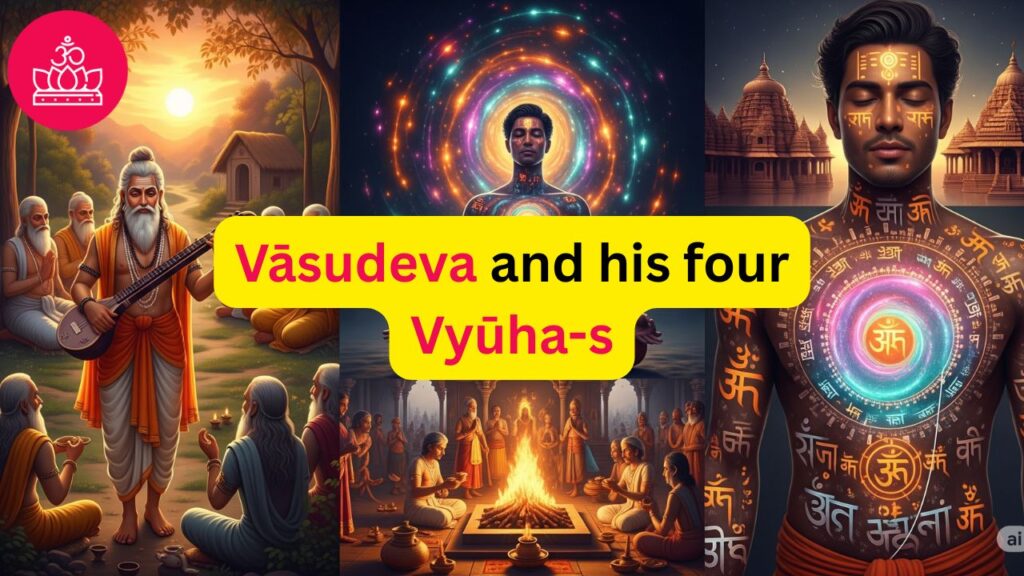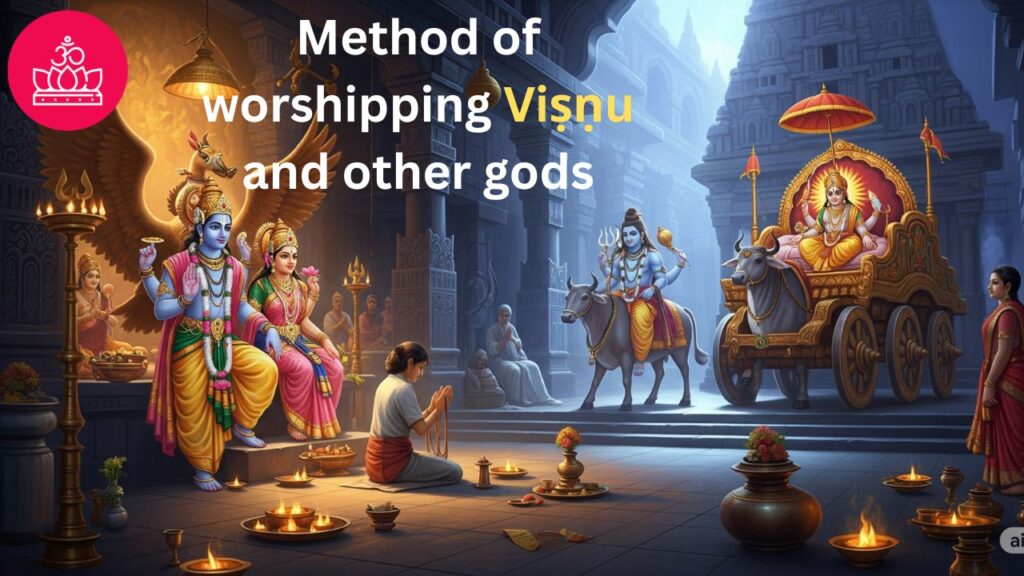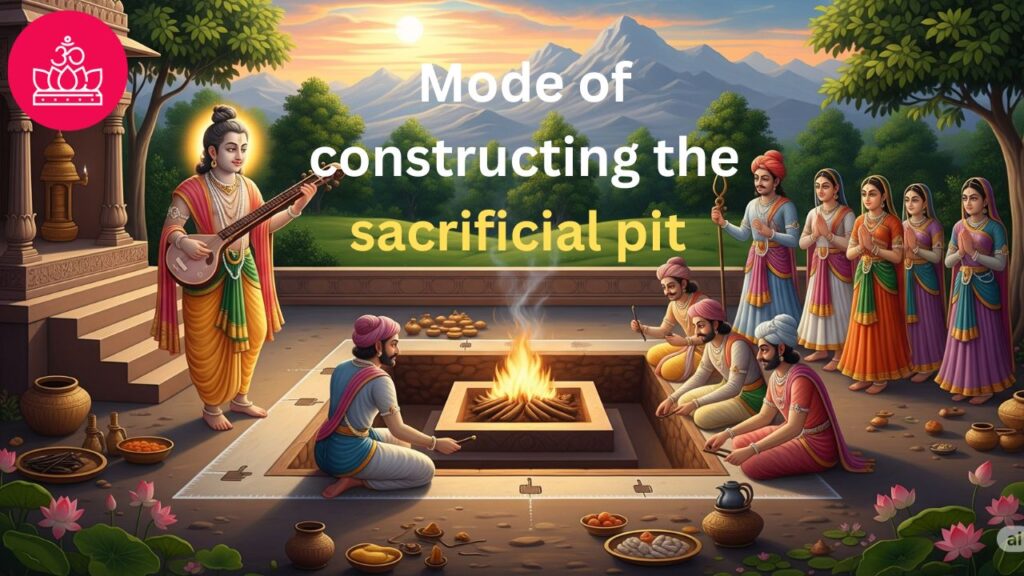The Divine Formulae: A Guide to the Worship of Vasudeva and His Manifestations
As told in: Agni Purana – Chapter 25: The formulae and mode of worship relating to Vāsudeva, Saṅkarṣaṇa, Pradyumna and Aniruddha
This chapter of the Agni Purana unveils a profound and intricate system of worship dedicated to Vasudeva and his three principal manifestations: Sankarshana, Pradyumna, and Aniruddha. It’s not merely a ritualistic guide but a pathway to deeper understanding and communion with the divine, revealing the interconnectedness of the cosmos and the human self. Narada, the revered sage, imparts this sacred knowledge, guiding us through a complex yet ultimately harmonious process of devotional practice.
# Unveiling the Fourfold Form: Vasudeva and His Expansions
The narrative commences with Narada’s declaration of his intent to reveal the “adorable formulae” related to the four principal forms of the divine: Vasudeva, Sankarshana, Pradyumna, and Aniruddha. This establishes the core subject matter and sets the stage for a detailed exploration of the methods of worship associated with each. The very mention of these names evokes a sense of awe and reverence, reminding us of the vastness and multifaceted nature of the divine. The four forms, while distinct, represent different aspects of the same ultimate reality, highlighting the unity underlying the diversity of the cosmos.
# The Mystical Syllables and Mantras: A Journey into Sound and Symbolism
The instruction then delves into the specifics of the mantras, emphasizing the importance of the sacred syllables ‘Om’, ‘a’, ‘ā’, ‘am’, and ‘aḥ’. These aren’t merely sounds; they are potent symbols imbued with spiritual power, acting as gateways to higher consciousness. The recitation of “Salutations to the Lord,” followed by “Salutations to Narayana,” establishes a foundation of devotion and reverence before proceeding to more complex invocations. The introduction of salutations to Brahma, Vishnu, and Narasimha further underscores the interconnectedness of the divine trinity within the overarching reality of Narayana.
The text then introduces a system of assigning specific syllables and deities to different parts of the body – a form of internalized yantra. This intricate process involves the precise arrangement of syllables (mantras) corresponding to various limbs, from the heart to the feet, creating a microcosm of the divine within the devotee. This practice isn’t merely mechanical; it’s a meditative technique aimed at unifying the physical body with the divine consciousness.
# Deities and Attributes: Mapping the Cosmos Within
The verses meticulously detail the allocation of specific mantras to various limbs, weapons, and ornaments associated with Vishnu and his avatars. The mantras for Vainateya (Garuda), Krishna’s brother, and the goddess Sri, each have their designated syllables and placements, demonstrating the holistic approach to devotion. The meticulous detailing of the mantras for Panchajanya (conch), Kaustubha (gem), Sudarshana (discus), and Srivatsa (mark) shows the deep connection between the devotee’s body and the divine attributes represented by these objects. This meticulous arrangement is not arbitrary but symbolic, connecting the worshipper’s physical being to the divine cosmic order.
The mention of Ananta (the infinite serpent) adds another layer to the cosmic symbolism. The instruction to repeat the Pranava (Om) five times followed by the mention of body parts five times underscores the importance of repetition in deepening the meditative state and establishing a resonant connection with the divine.
# The Five Elements and Beyond: Embodying the Cosmic Principles
The chapter progresses to a higher level of symbolism, connecting the worship to the five elements (earth, water, fire, air, ether) and the five senses. The allocation of Vedic hymns (Rigveda, Yajurveda, Atharvaveda) to different parts of the body further integrates the worshipper into the vast tapestry of Vedic knowledge. This isn’t just about reciting mantras; it’s about internalizing the cosmic principles and experiencing them within one’s being.
The introduction of the seven principles (earth, ether, heaven, mahas, jana, tapa, satya) and their assignment to specific body parts further deepens the symbolic connection. The detailed description of the Agniṣṭoma, Vājapeya, and other sacrificial rites indicates the connection between this personal, internalized worship and the larger, ritualistic practices of Vedic tradition.
# The Vyūhas and the Multiplicity of the Divine
The concept of Vyūhas (manifestations) is introduced, highlighting the multiple aspects of the divine within the single, ultimate reality. The description of the eight and nine-part manifestations of the divine further emphasizes the multifaceted nature of the divine. The allocation of these aspects to different fingers and body parts underscores the comprehensive nature of the devotional practice, ensuring that all aspects of the devotee’s being are engaged in the worship.
# Indra and Vishnu: The Divine Presence in All
The chapter then highlights the pervasiveness of Indra and Vishnu, showing how the divine energy permeates every aspect of existence. The detailed instructions on assigning specific attributes and aspects of the divine to various body parts – from the head to the feet – show the holistic nature of this worship. This is not a mere ritual; it’s a profound meditative practice that aims to unite the devotee’s consciousness with the divine.
The listing of Vishnu’s various names (Vishnu, Madhuhara, Trivikrama, etc.) further underscores the multiplicity of divine manifestations, demonstrating that the ultimate reality is beyond any single definition or form.
# The Twenty-Six Parts: A Microcosm of the Cosmos
The chapter culminates in the description of the twenty-six parts representing the supreme being, intellect, ego, senses, and elements. The careful assignment of these parts to different body parts illustrates the microcosmic nature of the human being, reflecting the macrocosm of the universe. This detailed process transforms the act of worship into a profound meditative journey, connecting the worshipper to the vast cosmic order.
The final instructions on the circular altar and the placement of deities in different directions emphasize the importance of spatial orientation in ritualistic practices. The inclusion of guardian deities of the quarters underscores the importance of acknowledging the larger cosmic framework within which the individual worship takes place.
# Conclusion: A Path to Union with the Divine
The Agni Purana’s description of the worship of Vasudeva and his manifestations is not a mere list of rituals, but a profound spiritual guide. It uses intricate symbolism and meticulous detail to lead the devotee on a path of self-realization and union with the divine. The emphasis on internalizing the cosmic principles through the precise arrangement of mantras and their association with body parts creates a powerful meditative practice. The chapter ends with the promise of fulfilling desires, but the true reward lies in the profound transformation of consciousness that this practice aims to achieve. It is a testament to the richness and depth of ancient Hindu spiritual thought, offering a pathway to a deeper understanding of the divine and oneself.



